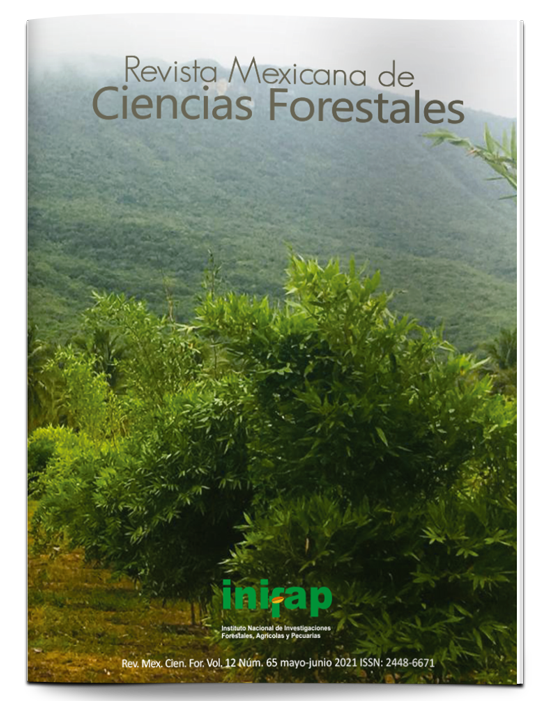Regeneración natural de pino y encino bajo diferentes niveles de perturbación por incendios forestales
DOI:
https://doi.org/10.29298/rmcf.v12i65.776Palabras clave:
Fuego, perturbación intermedia, régimen del fuego, resiliencia, respuesta de la vegetación, severidad de incendios forestalesResumen
El comportamiento de los incendios forestales varía debido a diversos factores, donde el nivel de severidad condiciona la respuesta que tendrán los ecosistemas ante el fuego, como lo es la capacidad de regeneración natural. No obstante, poco se ha estudiado al respecto en México, lo que ha limitado las estrategias de restauración. De acuerdo a esto, se realizó un análisis comparativo de la respuesta de la regeneración natural del arbolado en tres rangos de altura (0–0.30 m, 0.31–1.0 m y 1.1– 3.0 m), considerando un diseño experimental con dos factores: 1) diferentes condiciones de severidad del incendio (sin incendio, incendio moderado, incendio extremo); y 2) tres regiones de bosques de pino-encino (Sierra de Quilla, el bosque La Primavera y la Sierra de Tapalpa, Jalisco). Para el análisis comparativo se generaron ANOVA y prueba de Tukey, con base a diseño experimental factorial (región y severidad). Los resultados sugieren que existe una diferencia significativa entre las condiciones de severidad de los incendios y entre las regiones, para el rango de altura de 0 a 0.30 m, apreciándose una mayor regeneración en las áreas con incendios moderados. Esto se remarca, en Tapalpa donde se estiman en promedio 160,000 individuos ha-1. Por otra parte, con respecto los otros estratos de regeneración (0.31 –1.0 m y 1.1–3.0 m) no se encontraron diferencias significativas entre las condiciones de severidad del fuego, considerando solo la regeneración de pino. Se concluye que la ocurrencia de un incendio moderado puede propiciar una mayor incidencia de regeneración natural.
Descargas
Descargas
Publicado
Cómo citar
Número
Sección
Licencia
Los autores que publiquen en la Revista Mexicana de Ciencias Forestales aceptan las siguientes condiciones:
De acuerdo con la legislación de derechos de autor, la Revista Mexicana de Ciencias Forestales reconoce y respeta el derecho moral de los autores, así como la titularidad del derecho patrimonial, el cual será cedido a la revista para su difusión en acceso abierto.
Todos los textos publicados por la Revista Mexicana de Ciencias Forestales –sin excepción– se distribuyen amparados bajo la licenciaCreative Commons 4.0 Atribución-No Comercial (CC BY-NC 4.0 Internacional), que permite a terceros utilizar lo publicado siempre que mencionen la autoría del trabajo y a la primera publicación en esta revista. (no permite el uso comercial)
Los autores pueden realizar otros acuerdos contractuales independientes y adicionales para la distribución no exclusiva de la versión del artículo publicado en la Revista Mexicana de Ciencias Forestales (por ejemplo, incluirlo en un repositorio institucional o darlo a conocer en otros medios en papel o electrónicos) siempre que indique clara y explícitamente que el trabajo se publicó por primera vez en la Revista Mexicana de Ciencias Forestales.
Para todo lo anterior, los autores deben remitir el formato de carta-cesión de la propiedad de los derechos de la primera publicación debidamente requisitado y firmado por los autores/as. Este formato debe ser remitido en archivo PDF al correo: editorial.forestal@inifap.gob.mx
Esta obra está bajo una licencia de Creative Commons Reconocimiento-No Comercial 4.0 Internacional.






